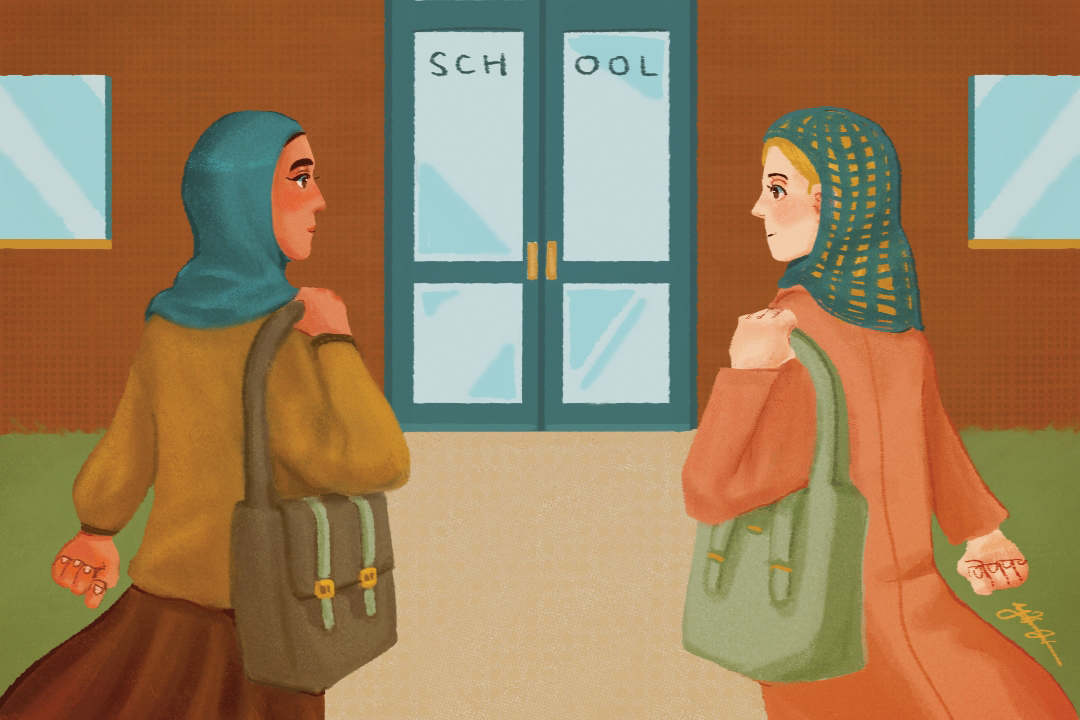With 102.6 million videos hashtagged on TikTok, 248,000 posts on Instagram, and a 5,000 per cent search increase in the past 12 months on Google, head coverings — specifically balaclavas — have likely never been so popular in history.
While fashion designers, celebrities, and social media have popularized the balaclava as a trendy winter garment in a mask-mandated world, this head covering was originally worn in 1854 by European soldiers fighting in frozen conditions during the Crimean War.
Regardless of the amount of enthusiasm it has generated from the public, the balaclava sparked controversy when Vogue France commented “Yes to the headscarf!” on a picture of American actress Julia Fox wearing a headscarf styled like a babushka during Paris Couture Week back in January.
Rage flooded the comments. Vogue France’s response highlighted the double standard in France: Muslim girls have been banned from wearing headscarves in public schools since 2004, but fashion icons are praised for wearing the same thing.
The history of hijab bans
Back in 2010, France was the first European country to enforce a nationwide ban to prohibit full-face veils like niqabs in public spaces. Even during the pandemic, France made it mandatory to wear masks in public while it continued to ban Muslims from wearing face coverings. Last year, the French Senate voted to add an amendment to an anti-separatism bill that would ban women under 18 from wearing a hijab in public. And this past January, the Senate proposed a ban on wearing hijab in sports competitions.
France is not the only country to limit hijab-wearing. Québec passed Bill 21 in 2019, which prohibited public servants such as teachers, police officers, and lawyers from wearing religious items such as hijabs, crosses, turbans, and yarmulkes during work.
Although officials argue that the ban on head coverings aims to promote women’s equality, secular tradition, and diversity, the restrictive laws are counterproductive because they discard the rights of Muslim women, attempt to assimilate religious practices, and could create ethnoreligious division. The ban strips away the liberal aspect of liberal democracy: rights of the minority must be protected regardless of the rule of the majority. In the case of the hijab ban, the rights of Muslim women are neither sanctioned nor respected by the law.
Uncovering the double standard for head coverings
The double standard of head coverings is not new.
When Kim Kardashian wore a burqa-like full-body cover to the Met Gala, she was not denounced as an extremist but described as “new” and “inventive.” When Olivia Rodrigo posted a picture wearing a balaclava, people adored the photo and left comments calling her “queen.” Audrey Hepburn, who extensively wore headscarves that covered her hair and neck in daily life, was praised for her beauty and was seen as a “timeless style icon.” When it’s in the name of fashion, it’s celebrated; when it’s in the name of religion, it’s frowned upon.
When Black people wear hoodies, they expose themselves as police targets due to the garment’s stereotypical signalling of gang-related activity in Black communities. Hence, the hoodie has become an active device for racial profiling and searching for criminality, especially in the United States.
When Muslim women wear head coverings, they face discrimination at work, encounter verbal and physical abuse, and are seen as oppressed.
When European celebrities wear head coverings, they are seen as fashion icons. When Black men wear head coverings, they are identified as criminals. When Muslim women wear head coverings, they are treated as terrorists.
It is ridiculous that the balaclava is considered trendy and forward but the hijab is considered oppressive and backward. The hijab can be oppressive only when it is enforced on anyone, like it is for many in the Middle East where women are still fighting for the choice to not wear one. Nevertheless, it is proudly worn by many in North America as a symbol of empowerment.
In democracies, people have the right to wear what they want — either to cover up or show parts of their body in public — because they have the freedom of choice. Balaclavas, babushkas, hijabs, and hoodies are all head coverings. Regardless of whether people wear head coverings religiously or stylishly, those garments should be viewed equally under the law.
I am by no means denouncing people who wear the balaclava, nor am I stating that it is cultural appropriation to wear one. By all means, wear it with pride. What I am saying is this: when you are wearing a balaclava, understand that it’s a privilege to wear one freely without the fear of discrimination, brutality, or punishment, as many people in the world are judged, abused, and penalized for doing the same thing.
Although laws are made by governments, they are enforced through popular opinion. Hopefully, as a result of the balaclava trend, people can change the double standard about head coverings in Western society.
Stephanie Shih is a first-year social sciences student at Woodsworth College.


